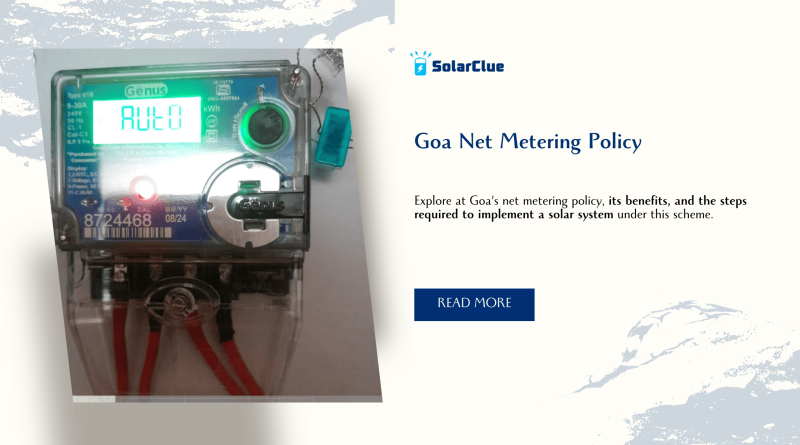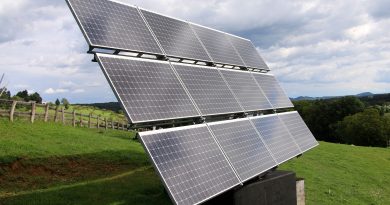Goa Net Metering Policy
Goa, known for its abundant sunshine, is an ideal location for solar energy generation. To promote the adoption of renewable energy, the Government of Goa has introduced the Net Metering Policy. This policy allows residents, businesses, and institutions to install solar power systems, generate their own electricity, and export any excess energy back to the grid. The net metering system not only helps consumers reduce their electricity bills but also contributes to environmental sustainability by promoting cleaner, greener energy sources.
In this blog, we’ll take an in-depth look at Goa’s net metering policy, its benefits, and the steps required to implement a solar system under this scheme.
Table of Contents
- 1 What is Net Metering?
- 1.1 Key Features of Goa’s Net Metering Policy
- 1.2 1. Eligibility Criteria
- 1.3 2. Solar System Capacity
- 1.4 3. Billing and Settlement
- 1.5 4. Installation and Maintenance
- 1.6 5. Government Incentives and Subsidies
- 1.7 Benefits of Net Metering in Goa
- 1.8 1. Reduced Electricity Bills
- 1.9 2. Environmental Sustainability
- 1.10 3. Energy Independence
- 1.11 4. Long-Term Financial Savings
- 1.12 Key Highlights of Goa’s Net Metering Policy
- 1.13 How to Apply for Net Metering in Goa
- 1.14 1. Eligibility Check
- 1.15 2. Select an Approved Vendor
- 1.16 3. Submit Application for Net Metering
- 1.17 4. Install Bi-Directional Meter
- 1.18 5. System Inspection and Approval
- 1.19 6. Start Generating Energy
- 1.20 Estimated Cost of Net Metering System in Goa
- 1.21 Estimated Cost for Solar System Installation in Goa
What is Net Metering?
Net metering is a billing mechanism that enables consumers to generate their own electricity through solar power and feed any excess electricity back into the grid. The energy exported is tracked via a bi-directional meter, and consumers earn credits that can be used to offset future electricity bills. The consumer is billed based on the net energy consumed—calculated as the difference between the energy imported from the grid and the energy exported to the grid.
Goa’s net metering policy incentivizes the adoption of solar power, making it easier and more affordable for consumers to generate their own clean energy and reduce their dependence on conventional electricity sources.
Key Features of Goa’s Net Metering Policy
1. Eligibility Criteria
- Consumer Categories: Residential, commercial, industrial, and institutional consumers are eligible.
- System Size: Solar rooftop systems ranging from 1 kW to 1 MW are allowed under the policy.
- Connection Type: Consumers must be connected to the grid through the Goa Electricity Department (GED).
2. Solar System Capacity
- The solar capacity of the rooftop system should not exceed the sanctioned load or contract demand of the consumer’s existing connection.
- The maximum allowable solar capacity for residential and commercial consumers is 80% of their sanctioned load.
3. Billing and Settlement
- A bi-directional meter is installed to record both the energy consumed from the grid and the energy exported to the grid.
- Consumers are billed based on the net energy used (imported minus exported).
- Settlement Period: Energy credits are settled on a monthly basis, and any surplus credits are carried forward to the next billing cycle.
4. Installation and Maintenance
- The cost of installing the solar power system is borne by the consumer.
- Maintenance of the system is the consumer’s responsibility, including regular cleaning of panels and inspection of equipment.
- The solar system must be installed by approved vendors to ensure compliance with GED’s technical standards.
5. Government Incentives and Subsidies
- The Ministry of New and Renewable Energy (MNRE) offers subsidies of up to 40% for solar systems up to 3 kW and 20% for systems between 3 kW and 10 kW.
- Goa also offers state-level incentives to encourage the installation of solar rooftop systems.
Benefits of Net Metering in Goa
1. Reduced Electricity Bills
Net metering allows consumers to reduce their electricity costs by generating their own solar power. Any surplus energy exported to the grid earns credits, which can offset future electricity consumption.
2. Environmental Sustainability
By generating solar power, consumers reduce their reliance on fossil fuels and contribute to reducing carbon emissions. This helps Goa achieve its renewable energy goals and promotes cleaner energy production.
3. Energy Independence
Consumers who adopt net metering become more energy-independent. By generating and using their own power, they rely less on the grid and are protected from rising electricity tariffs and power outages.
4. Long-Term Financial Savings
Although the initial investment for installing a solar system may be high, net metering ensures long-term savings by reducing electricity bills and providing financial returns over time. The payback period for solar systems typically ranges between 5 to 8 years.
Key Highlights of Goa’s Net Metering Policy
| Aspect | Details |
|---|---|
| Eligible Consumers | Residential, Commercial, Industrial, and Institutional |
| System Size | 1 kW to 1 MW |
| Maximum Solar Capacity | Up to 80% of sanctioned load |
| Billing Mechanism | Net metering with bi-directional meter |
| Excess Energy Settlement | Monthly credit for surplus energy exported to the grid |
| Meter Type | Bi-directional meter to track both import and export |
| Subsidies | Up to 40% for systems up to 3 kW; 20% for systems between 3 kW and 10 kW |
| Connection | Must be connected to Goa Electricity Department (GED) grid |
| Settlement Period | Monthly, with credits carried forward |
| Energy Credit Validity | Surplus credits can be carried over to offset future billing cycles |
| Maintenance | Consumer responsible for system maintenance |
| Government Incentives | MNRE subsidies and state incentives for solar rooftop installations |
| Environmental Impact | Promotes clean energy, reduces carbon emissions |
How to Apply for Net Metering in Goa
1. Eligibility Check
Ensure that your residential or commercial property qualifies for net metering. Your solar system capacity should not exceed 80% of your sanctioned load, and you must be connected to the GED grid.
2. Select an Approved Vendor
Choose an approved solar vendor or installer who complies with the technical and safety standards of the Goa Electricity Department. Ensure that the vendor is certified and experienced in installing solar systems in Goa.
3. Submit Application for Net Metering
Submit an application to the Goa Electricity Department (GED) to connect your solar system to the grid. The application can be submitted online or through the local GED office.
4. Install Bi-Directional Meter
A bi-directional meter is required to track both the energy you consume from the grid and the energy you export back to the grid.
5. System Inspection and Approval
Once your solar system is installed, it will be inspected by GED officials to ensure compliance with technical standards. Upon approval, your system will be connected to the grid under the net metering policy.
6. Start Generating Energy
Once your system is connected to the grid, you can start generating solar power. Any excess energy you produce will be exported to the grid, earning you credits that will lower your future electricity bills.
Estimated Cost of Net Metering System in Goa
The cost of setting up a solar power system under net metering in Goa depends on factors such as system size, equipment quality, and installation costs. Below is an estimated cost breakdown for 1 kW, 3 kW, and 5 kW solar systems in Goa.
Estimated Cost for Solar System Installation in Goa
| Component | 1 kW System | 3 kW System | 5 kW System |
|---|---|---|---|
| Solar Panels | ₹25,000 – ₹40,000 | ₹75,000 – ₹1,20,000 | ₹1,25,000 – ₹2,00,000 |
| Inverter | ₹6,000 – ₹12,000 | ₹18,000 – ₹36,000 | ₹30,000 – ₹60,000 |
| Bi-Directional Meter | ₹5,000 – ₹10,000 | ₹5,000 – ₹10,000 | ₹5,000 – ₹10,000 |
| Mounting Structure | ₹1,500 – ₹3,000 | ₹4,500 – ₹9,000 | ₹7,500 – ₹15,000 |
| Wiring and Cabling | ₹2,000 – ₹4,000 | ₹6,000 – ₹12,000 | ₹10,000 – ₹20,000 |
| Installation and Labor | ₹5,000 – ₹8,000 | ₹10,000 – ₹15,000 | ₹15,000 – ₹25,000 |
| Total Estimated Cost | ₹44,500 – ₹77,000 | ₹1,18,500 – ₹2,02,000 | ₹1,92,500 – ₹3,30,000 |
Conclusion
Goa’s net metering policy provides an excellent opportunity for consumers to generate their own renewable energy, reduce their electricity bills, and contribute to environmental sustainability. With attractive government subsidies, long-term financial benefits, and the ease of net metering, it’s an ideal time for residents and businesses in Goa to invest in solar rooftop systems.
Ready to Save on Electricity Bills with Solar Power?
With Net Metering, you can drastically reduce your electricity costs by generating your own solar power and sending any excess back to the grid. It’s time to harness the sun’s energy and make a positive impact on both your wallet and the environment!
At SolarClue, we make the transition to solar simple, efficient, and affordable. Whether you’re a homeowner, business, or institution, our team of solar experts will guide you through the process—from installation to maintenance—so you can start saving from day one.
🌞 Take the first step towards energy independence today!
🔋 Get your solar consultation now!
Contact SolarClue or call us at +91-888-4444-830 to explore the best solar solutions for your home or business.
Go Solar. Save More. Power Your Future with SolarClue!
FAQs
1. What is the maximum solar capacity allowed under Goa’s net metering policy?
The maximum capacity allowed is 1 MW, but it should not exceed 80% of the consumer’s sanctioned load.
2. How does net metering help reduce electricity bills in Goa?
By generating your own electricity and exporting excess energy to the grid, you earn credits that can offset future electricity bills, resulting in reduced costs.
3. What subsidies are available for solar installations in Goa?
The MNRE offers up to 40% subsidy for systems up to 3 kW and 20% for systems between 3 kW and 10 kW. State incentives are also available to promote solar installations.
4. What is the typical payback period for solar systems under net metering in Goa?
The payback period for solar systems typically ranges between 5 to 8 years, depending on the size of the system and electricity consumption.
5. Is net metering available for businesses in Goa?
Yes, commercial and industrial consumers are eligible to benefit from net metering under Goa’s policy.




